| |
|
|
| |
 |
|
| |
Alpenglow on Mt. Hood |
|
| |
|
|
| |
It could be the perfect subject for its own Trivia game: What National Historic Landmark sits on the flanks of a dormant volcano, known to Native Americans as Wy’east, the dwelling place of spirits? What structure, dedicated by a President, and its surrounding area served as the backdrop for a number of Hollywood productions? Who named a hill for a movie producer and dedicated a chairlift to a famous Italian clothing designer?
Where was the world’s second chairlift constructed, whose image was carried by a generation of Baby Boomers? Who was the world’s first purveyor of lift-served summer skiing, drawing Olympic ski teams from around the world in the 1950s and 60s for their summer training? What is the only resort in the world that can be skied 365 days a year on lift-served slopes?
The one answer to all these questions: Oregon's Mt. Hood's Timberline Lodge.
In 1915, at the timber line of Mt. Hood where woodland gives way to scrub, the U.S. Forest Service built a small cabin for use as an emergency shelter. In 1924 it was replaced by the “Hotel at Timberline,” erected on a fairly level spot with a source of drinking water. Measuring 8-feet by 16-feet with three tents, meals were included but you’d better bring your own blanket. |
|
| |
|
|
|
|
| |
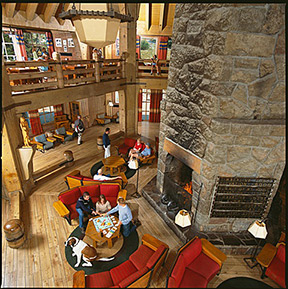 |
|
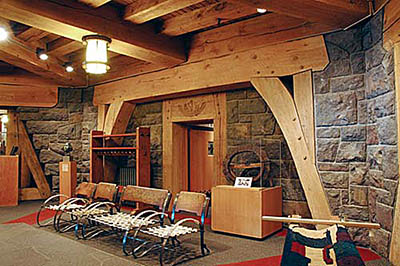 |
|
| |
Timberline’s mammoth fireplace actually encloses six fireplaces – three each on the first and second floors. |
|
Cascadian architecture features massive beams and enormous amounts of stonework.
Image courtesy of Oregon Blue Book |
|
| |
|
|
| |
In 1937, the Works Progress Administration/Civilian Conservation Corps undertook a make-work project employing over 500 local men and women struggling through the Great Depression. These artisans, craftsmen and laborers poured their hearts into the task of creating a Cascadian-style lodge on the very breast of Mt. Hood, near the original “Hotel."
A hexagonal stone fireplace, 92’ tall and 14’ in diameter, was assembled from 400 tons of stone and capped with a 750-pound bronze and brass weathervane. Thirty-foot logs from nearby Mt. Adams were shaped into hexagonal pillars three feet in diameter. The Blue Ox Bar was ornamented with stained glass murals of Paul Bunyan, Babe and a bas relief mountain covering an entire wall. Each guest room was uniquely decorated, the upholstery fabric woven on hand looms. One hundred pair of curtains and 152 bedspreads were appliquéd with floral designs; 199 hooked rugs were made from old CCC uniforms and army blankets dyed earth tone colors. |
|
| |
|
|
| |
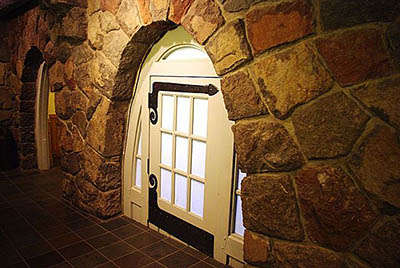 |
|
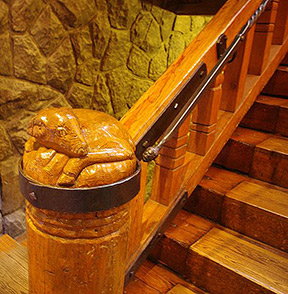 |
|
| |
Windows and doors are inset in native stone, and newel posts are carved with animals such as this ram. Images courtesy of Wikipedia Commons |
|
| |
|
|
| |
The main (upstairs) front door is a 700-pound, five-foot by ten-foot hunk of hand-cut Ponderosa Pine. Loaded with 400 pounds of hand-forged ironware, hinges, latch and knocker, it is balanced so well it opens with a light touch. Cedar newel posts on the stairways were carved in the likenesses of bear, beaver, coyote, wildcat and badger. Hand-crafted furnishings paid tribute to early pioneers who struggled across this final barrier to the western terminus of the Oregon Trail. The spirit of Northwest Native Americans was honored in wood carvings and wrought iron designs. |
|
| |
|
|
| |
Timberline Lodge is a treasure trove of CCC-era craftsmanship and artwork including mosaics, murals, paintings, weavings and carvings. Images courtesy of Oregon Blue Book-left and Oregon State Archives-right |
|
| |
Franklin D. Roosevelt dedicated Timberline Lodge “as a place to play for generations of Americans.” Image on right courtesy of Library of Congress Prints & Photographs Division |
|
| |
|
|
| |
In June 1937, more than 3,000 people attended the Lodge’s open house and watched the Golden Rose Ski Race, which was to become the longest continually run ski race in the world. President Franklin Delano Roosevelt made the official dedication in September that year, and two months later Sir Arnold Lunn, editor of the British Ski Year Book and a driving force behind the development of skiing in Europe, was at hand for the opening race of the season.
By the way—on a June day in the late 60s, my duties as a gatekeeper for the Golden Rose race were challenged by a raging snowstorm cloaking the top and bottom set of gates assigned to my observant eye. One never knows what Wy’east weather will toss out—I’ve skied these slopes in August flurries and on powder-and-bluebird-sky days in January. |
|
| |
|
|
| |
A “snow cat” was developed to help in construction of the Lodge. |
|
A winter snow tunnel is erected over the main entry of the Lodge to aid access in snowfalls that have, in the past, nearly buried the three-story structure. Image courtesy of rhiza A+D Architect |
|
| |
|
|
| |
Construction of the Lodge brought another reward to future generations of skiers. A September 1936 newspaper article noted that a “snow cat” had been developed by I.F. Davidson, working on site, to assist in building the hotel. This machine could climb 40% grades, carry its own weight, and operate at 25 miles per hour. This is perhaps the first mention of the machines that revolutionized trail maintenance at winter resorts around the world.
Timberline’s snowcats, which for years were the only way to reach the year-round snowfields beckoning below Crater Rock, gave rise to a spring day of insanity in the early 70s. I somehow thought a good way to overcome my fear of heights might be to purchase a hang glider, load it in the back of a ‘cat, head uphill and sail back to the Lodge with skis dangling from my feet. As I harnessed up and prepared to take flight, I looked down. The Lodge looked like a toothpick tossed onto the slope waaaay below me. To be precise, three-thousand vertical feet below me. I spent the next 45 minutes trying to catch just enough air to skim my skis a few inches above the snow, all the way back to where I had left my good sense. (When I got home, I wisely, and to my parents relief, traded the hang glider for a canoe.)
But I am just one small entity in the long line of skiers who have been coming to Mt. Hood since the early 1900s. |
|
| |
|
|
| |
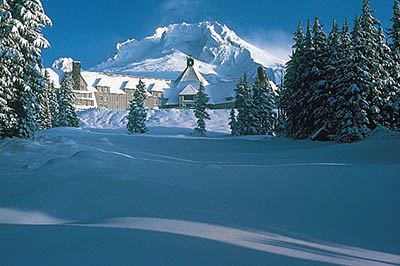 |
|
| |
One of the Northwest’s most iconic images: Timberline Lodge’s majestic location on the snow-blanketed slopes of Mt. Hood, Oregon |
|
| |
|
|
| |
When the Magic Mile chairlift began operation in 1938, transporting 255 passengers an hour, it was the second chairlift in the world (Sun Valley boasting #1), the first with metal towers, and the longest (4,950 feet). Sometimes the snow fell so deep, skiers had to ascend to the unloading station at Silcox Hut between snowbanks that loomed above their heads. WWII’s gas and tire rationing brought a 50% drop in business and the doors closed from 1942-1945. In 1948 a new paved road from Government Camp made the trek up the mountain a safer, if less adventurous trip. |
|
| |
|
|
| |
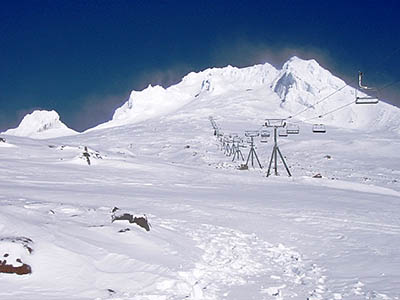 |
|
| |
The Palmer lift and snowfield appear to stretch all the way to Crater Rock and nearly the summit of Mt. Hood. Image by Vicki Andersen |
|
| |
|
|
| |
Meanwhile, the Palmer snowfield gleamed from the upper reaches of the mountain. Permanent and stationary, unlike a glacier, it offered 450 acres buried in 30 feet of snow. A portable Poma lift was set up in 1956, and the Timberline Race Camp was underway. Eventually the mountain played host to national ski teams and academies from all over the United States, Canada and Japan. With the installation of the Palmer Chair, the summer of 1978 heralded the first lift-serviced summer skiing in the United States. |
|
| |
|
|
| |
|
|
| |
Pool off the West Wing of Timberline Lodge |
|
| |
|
|
| |
In the mid-1950s the Pucci chair was installed in the location originally developed by future clothing designer Emilio Pucci while he was a young skier and Reed College student in Portland. In 1957 the Betsy rope tow was lit for night skiing, and by 1959 après-ski could include a swim in the new pool. In 1962 the original Magic Mile lift was dismantled and a new lift installed to the west of the pool. Ten years later Timberline Lodge was added to the National Register of Historic Places. In 1975 a convention wing was constructed to accommodate the growing number of groups who wanted to hold meetings in such a unequaled setting.
In 1981, the 40,000+ square-foot Wy’east Day Lodge was built to accommodate the increasing number of visitors, which now topped one million each year. Housing all skier services, it complements the design of the original Lodge and is decorated with enameled metal friezes, airbrushed/silk-screened pieces, glass sculptures and partitions, as well as hand woven tapestries. |
|
| |
|
|
| |
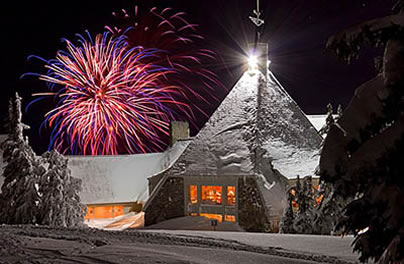 |
|
|
|
| |
Fireworks at Timberline Lodge
|
|
Numerous movies filmed in and around Timberline Lodge include 1960’s “All the Young Men” starring Alan Ladd and Sidney Poitier. Image courtesy Columbia Pictures |
|
| |
|
|
| |
Ongoing additions and upgrades in uphill conveyances included expanding terrain. Always the perfect family area, Timberline offers enough challenge to tickle the fancy of the hardcore while excelling in fun, playful runs. An example is the open slope east of the Magic Mile named for Otto Lang who taught a pre-war generation to love skiing and Timberline, before he gave up instructing and headed to Hollywood to make movies.
In return, Hollywood discovered Otto’s old haunt. I remember how odd it appeared, seeing familiar terrain overrun with a movie crew and actors dressed as soldiers, transforming my winter playground into a WWII battlefield as they filmed “All the Young Men.” Besides this epic, Timberline provided the background for a number of films including James Hilton’s 1972 “Lost Horizon,” “Bend in the River” with James Stewart, and Stanley Kubrick’s “The Shining.” |
|
| |
|
|
| |
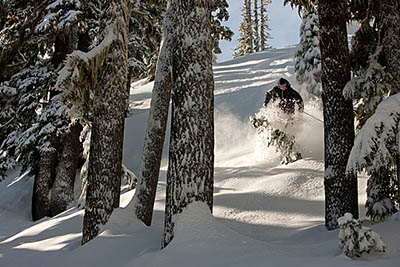 |
|
| |
Above the Lodge is mostly open terrain while an abundance of trees adorn the lower slopes. |
|
| |
|
|
| |
I spent a quarter of a century teaching on these slopes, appreciating the variety of available terrain. Novices are encouraged by smooth, gentle trails winding down the mountain. Intermediates enjoy challenging themselves with short bump runs and brief steep sections. As the freestyle rage of the late 1960s arrived, I sought out morsels like West Pitch on which to teach Daffys and Shoulder Rolls, and wide forgiving slopes such as Gordo’s Mile on which to perfect Royale Christies and Kahua Thumpers. I welcomed the deep, early November snowfalls which allowed time to hone skills for the coming season, and spring in which to shed the confines of winter responsibilities and revel in months of corn conditions. |
|
| |
|
|
| |
Silcox Hut provides a scenic daytime retreat and an unparalleled nighttime respite. |
|
| |
|
|
| |
Nestled into the mountain at the 7,000-foot level, Silcox Hut once gave skiers a sheltered place to unload from the original Magic Mile chairlift and warm up from the winds which can howl across the open upper slopes. This very chair was the inspiration for the skier image found among the artwork on the Pee Chee folders ubiquitous among school kids in the 1950s and 60s. Now you can spend a comfortable night, including meals, in this historic structure.
Non-snowsliders can enjoy a winter visit via snowshoe trek or, weather permitting, a Magic Mile Sky Ride to soak up the panoramic view. Foothills interlaced with lakes and the frosted runs of lower-elevation ski areas unfold at your feet. Snow-capped Mt. Jefferson and the Three Sisters line the southern horizon. The uphill view encompasses Crater Rock, Illumination Point, and the craggy remains of the old crater.
Whether you journey here to slide on her wintry trails, play on her sun-drenched summer slopes, or marvel at the historical magnificence of the Lodge, visitors to Timberline are guaranteed a moving and inspirational experience. |
|
| |
|
|
| |
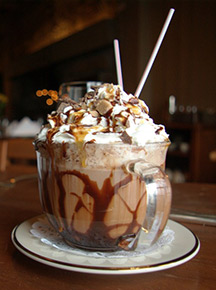 |
|
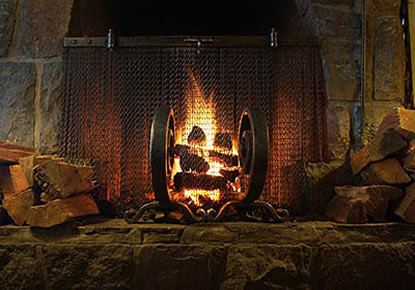 |
|
| |
Summer or winter, curling up in front of a fire with a mug of Timberline’s signature Hot Chocolate is the perfect ending to a day on Mt. Hood. |
|
| |
|
|
| |
MOUNTAIN STATS
Elevations: Top = 8,540‘/summer (Palmer), Bottom = 4,850’/winter (Still Creek Basin), Lodge = 6,000’
Lift-Served Vertical: Winter = 3,690’ (the most in the Pacific Northwest), Summer = 2,616’
Average Snowfall: 400-500”
Uphill Conveyances: 5 High-Speed Quads, 1 Triple, 1 Double, 2 Surface Tows, 1 Snowcat; Uphill Capacity: 9,869 people/hour
Terrain: 41 trails on 1,415 skiable acres; 5 Terrain Parks, 1 Pipe; Trail Mix: 25% Beginner, 50% Intermediate, 25% Advanced
Season: Year-Round except for a brief period after Labor Day when the lifts are closed for maintenance; 2 chairs illuminated for night skiing through March
SERVICES
Timberline Lodge: Cascade Dining Room, Ram’s Head Bar, Blue Ox Bar, 70 rooms, pool, hot tub, sauna, fitness room
Wy’east Day Lodge: Black Iron Grill & Market Café, lounge, rental shop (skis, boots, poles, snowboards, helmets, snowshoes), ski school (skiing, snowboarding, Timberline Summer Snow Camps), lockers, gift shop, skier services
INFORMATION
Location: 55 miles east of Portland on Highway 26; just east of Government Camp, proceed 6 miles up the Timberline Road
Contact: General Information 503-272-3311, Snow Conditions 503-222-2211, Reservations 800-547-1406, https://timberlinelodge.com/, information@timberlinelodge.com
|
|
| |
|
|
|
|
|
